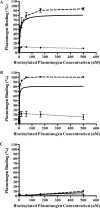The plasminogen-binding group A streptococcal M protein-related protein Prp binds plasminogen via arginine and histidine residues
- PMID: 17012384
- PMCID: PMC1797364
- DOI: 10.1128/JB.01218-06
The plasminogen-binding group A streptococcal M protein-related protein Prp binds plasminogen via arginine and histidine residues
Abstract
The migration of the human pathogen Streptococcus pyogenes (group A streptococcus) from localized to deep tissue sites may result in severe invasive disease, and sequestration of the host zymogen plasminogen appears crucial for virulence. Here, we describe a novel plasminogen-binding M protein, the plasminogen-binding group A streptococcal M protein (PAM)-related protein (Prp). Prp is phylogenetically distinct from previously described plasminogen-binding M proteins of group A, C, and G streptococci. While competition experiments indicate that Prp binds plasminogen with a lower affinity than PAM (50% effective concentration = 0.34 microM), Prp nonetheless binds plasminogen with high affinity and at physiologically relevant concentrations of plasminogen (K(d) = 7.8 nM). Site-directed mutagenesis of the putative plasminogen binding site indicates that unlike the majority of plasminogen receptors, Prp does not interact with plasminogen exclusively via lysine residues. Mutagenesis to alanine of lysine residues Lys(96) and Lys(101) reduced but did not abrogate plasminogen binding by Prp. Plasminogen binding was abolished only with the additional mutagenesis of Arg(107) and His(108) to alanine. Furthermore, mutagenesis of Arg(107) and His(108) abolished plasminogen binding by Prp despite the presence of Lys(96) and Lys(101) in the binding site. Thus, binding to plasminogen via arginine and histidine residues appears to be a conserved mechanism among plasminogen-binding M proteins.
Figures







Similar articles
-
The maintenance of high affinity plasminogen binding by group A streptococcal plasminogen-binding M-like protein is mediated by arginine and histidine residues within the a1 and a2 repeat domains.J Biol Chem. 2006 Sep 8;281(36):25965-71. doi: 10.1074/jbc.M603846200. Epub 2006 Jul 5. J Biol Chem. 2006. PMID: 16822869
-
Analysis of plasminogen-binding M proteins of Streptococcus pyogenes.Methods. 2000 Jun;21(2):143-50. doi: 10.1006/meth.2000.0985. Methods. 2000. PMID: 10816375
-
Coiled-coil structure of group A streptococcal M proteins. Different temperature stability of class A and C proteins by hydrophobic-nonhydrophobic amino acid substitutions at heptad positions a and d.Biochemistry. 1997 Apr 22;36(16):4987-94. doi: 10.1021/bi962971q. Biochemistry. 1997. PMID: 9125521
-
The streptococcal M protein: a highly versatile molecule.Trends Microbiol. 2010 Jun;18(6):275-82. doi: 10.1016/j.tim.2010.02.007. Epub 2010 Mar 27. Trends Microbiol. 2010. PMID: 20347595 Review.
-
Molecular mechanism of ferricsiderophore passage through the outer membrane receptor proteins of Escherichia coli.Biometals. 2007 Jun;20(3-4):263-74. doi: 10.1007/s10534-006-9060-9. Epub 2006 Dec 22. Biometals. 2007. PMID: 17186377 Review.
Cited by
-
Characterization of streptokinases from group A Streptococci reveals a strong functional relationship that supports the coinheritance of plasminogen-binding M protein and cluster 2b streptokinase.J Biol Chem. 2012 Dec 7;287(50):42093-103. doi: 10.1074/jbc.M112.417808. Epub 2012 Oct 18. J Biol Chem. 2012. PMID: 23086939 Free PMC article.
-
Defining the structural basis of human plasminogen binding by streptococcal surface enolase.J Biol Chem. 2009 Jun 19;284(25):17129-17137. doi: 10.1074/jbc.M109.004317. Epub 2009 Apr 10. J Biol Chem. 2009. PMID: 19363026 Free PMC article.
-
FabG moonlights as an extracellular adhesin mediates cytoadhesion of Streptococcus suis via interaction with plasminogen.BMC Microbiol. 2025 Jul 4;25(1):412. doi: 10.1186/s12866-025-04129-7. BMC Microbiol. 2025. PMID: 40615777 Free PMC article.
-
Streptococcus pneumoniae choline-binding protein E interaction with plasminogen/plasmin stimulates migration across the extracellular matrix.Infect Immun. 2008 Feb;76(2):466-76. doi: 10.1128/IAI.01261-07. Epub 2007 Dec 10. Infect Immun. 2008. PMID: 18070889 Free PMC article.
-
Characterization of cleavage events in the multifunctional cilium adhesin Mhp684 (P146) reveals a mechanism by which Mycoplasma hyopneumoniae regulates surface topography.mBio. 2012 Apr 3;3(2):e00282-11. doi: 10.1128/mBio.00282-11. Print 2012. mBio. 2012. PMID: 22493032 Free PMC article.
References
-
- Andronicos, N. M., M. Ranson, J. Bognacki, and M. S. Baker. 1997. The human ENO1 gene product (recombinant human alpha-enolase) displays characteristics required for a plasminogen binding protein. Biochim. Biophys. Acta 1337:27-39. - PubMed
-
- Ben Nasr, A., A. Wistedt, U. Ringdahl, and U. Sjobring. 1994. Streptokinase activates plasminogen bound to human group C and G streptococci through M-like proteins. Eur. J. Biochem. 222:267-276. - PubMed
-
- Berge, A., and U. Sjobring. 1993. PAM, a novel plasminogen-binding protein from Streptococcus pyogenes. J. Biol. Chem. 268:25417-25424. - PubMed
-
- Broder, C. C., R. Lottenberg, G. O. von Mering, K. H. Johnston, and M. D. Boyle. 1991. Isolation of a prokaryotic plasmin receptor. Relationship to a plasminogen activator produced by the same micro-organism. J. Biol. Chem. 266:4922-4928. - PubMed
-
- Carapetis, J. R., A. C. Steer, E. K. Mulholland, and M. Weber. 2005. The global burden of group A streptococcal diseases. Lancet Infect. Dis. 5:685-694. - PubMed
Publication types
MeSH terms
Substances
LinkOut - more resources
Full Text Sources
Research Materials
Miscellaneous

